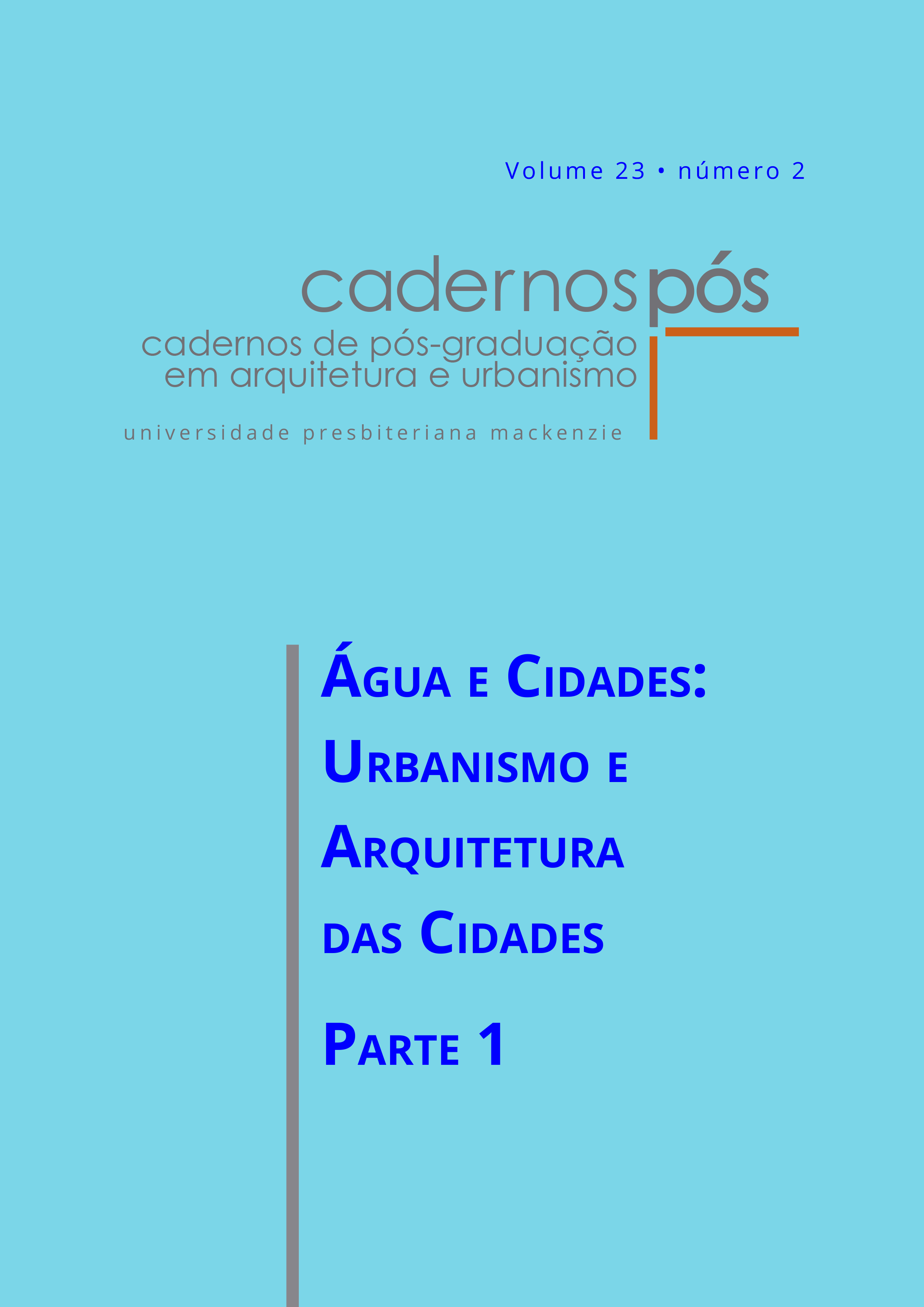Paisaje, raza y justicia ambiental en Macapá (AP)
reflexiones sobre la trama del agua y el tejido socio-racial de una ciudad amazónica
DOI:
https://doi.org/10.5935/cadernospos.v23n2p121-141Palabras clave:
Amazonía, Justicia ambiental, Planificación del paisaje, MacapáResumen
En las ciudades amazónicas, el proceso de urbanización mantiene similitudes con las ciudades del centro-sur del país, pero existe un intenso entrecruzamiento entre los procesos sociales y los sistemas ambientales (agua, vegetación y relieve), que le confieren la idiosincrasia de estos paisajes, al mismo tiempo que articula procesos de degradación ambiental con segregación racial. A pesar de los avances en los procesos de depredación en este contexto, este artículo busca comprender los procesos de urbanización en la ciudad de Macapá, identificando superposiciones entre la transformación de su red de agua y la exclusión de la población negra. Para ello, adopta un enfoque cualitativo, combinado con análisis documental y cartográfico, que incluye recortes espaciales de la parte central y la zona de expansión de la ciudad. La investigación se basa en los conceptos de ordenamiento del paisaje y justicia ambiental y revela que el avance de la urbanización ha alterado el territorio a través de cambios en las características biofísicas, con el fin de generar injusticia ambiental para ciertos grupos sociales históricamente marginados.
Palabras clave: Amazonía, justicia ambiental, planificación del paisaje, Macapá.
Descargas
Citas
ARAÚJO, R. As cidades da Amazónia no século XVIII: Belém, Macapá e Mazagão. Porto: Faup, 1998.
BEZERRA NETO, J. Escravidão negra no Grão-Pará. Belém: Paka-Tatu, 2001.
BRITO, D.; BASTOS, C.; FARIAS, R. Ambiente, cultura e territorialidade na Área de Proteção Ambiental do Rio Curiaú - AP. Ciência Geográfica, v. 21, n. 2, 2017.
BULLARD, R. Dumping in Dixie: race, class, and environmental quality. New York: Routledge, 1990.
CANTUÁRIA, E. APA do Rio Curiaú e a cidade de Macapá: relações sociais, jurídicas e ambientais. 2011. Dissertação (Mestrado em Direito Ambiental e Políticas Públicas) – Universidade Federal do Amapá, Macapá, 2011.
CARVALHO, B. Habitação popular na Amazônia: o caso das ressacas na cidade de Macapá. Curitiba: Appris, 2020.
CORNER, J. Terra Fluxus in Waldheim. Princeton: The Landscape Urbanism, 2006.
COMPANHIA DE PESQUISA DE RECURSOS MINERAIS (CPRM). Cartas de suscetibilidade a movimentos gravitacionais de massa e inundações. Belém: CPRM., 2015. [Cartografia digital, formato shapefile].
FUNDAÇÃO JOÃO PINHEIRO (FJP). Plano Diretor de Desenvolvimento Urbano (PDU). Macapá: Ministério do Interior, 1973.
GARCIA, M.; VASCONCELOS, A.; PONTES, L. A cidade no estuário do Rio Amazonas: mapeando apagamentos e sobrevivências na convivência com as águas na cidade de Macapá-AP. In: Encontro Nacional de Ensino de Paisagismo nas Escolas de Arquitetura do Brasil, 16., 2022, Cuiabá. Anais [...]. Cuiabá: Enepea, 2022.
INSTITUTO BRASILEIRO DE GEOGRAFIA E ESTATÍSTICA (IBGE). Censo demográfico 2010. Resultados do universo. Disponível em: http://www.ibge.gov.br. Acesso em: 7 jan. 2023.
INSTITUTO BRASILEIRO DE GEOGRAFIA E ESTATÍSTICA (IBGE). Contas regionais Amapá PIB 2019. Macapá: Seplan, 2021. Disponível em: https://editor.amapa.gov.br/arquivos_portais/publicacoes/SEPLAN_d186d52e74e6c70dc12e7a5a62a8c380.pdf. Acesso em: 7 jan. 2023.
HERCULANO, S. Riscos e desigualdade social: a temática da justiça ambiental e sua construção no Brasil. Indaiatuba: Encontro da ANPPAS, 2002.
HOUGH, M. Cities and natural process. Londres: Routledge, 1995.
MACEDO, L. Janarismo em foco: a representação fotográfica da cidade de Macapá durante a formação do Território do Amapá (1944-1956). 2020. Tese (Doutorado em Urbanismo) – Universidade Federal do Rio de Janeiro, Rio de Janeiro, 2020.
MARICATO, E. Urbanismo na periferia do mundo globalizado. Metrópoles brasileiras. São Paulo em Perspectiva, v. 14, n. 4, 2000.
MATSUNAGA, M. Quando a água vira cidade: urbanização e moradia em Macapá, AP. 2021. Tese (Doutorado em Urbanismo) – Universidade Federal do Rio de Janeiro, Rio de Janeiro, 2021.
McHARG, I. Design with nature. New York: American Museum of Natural History, 1969.
METZGER, J. O que é ecologia de paisagens? Biota Neotropica, Campinas, v. 1, n. 1, 2001.
PESSOA, M.; VENERA, R. (Re)pensando o passado e o presente dos afrodescendentes a partir da Fortaleza de São José de Macapá. Revista do Desenvolvimento Regional, v. 12, n. 2, 2015.
PONTES, L. Espaço (em) aberto: brechas à reinvenção do projeto e da paisagem, um estudo sobre a cidade de Macapá. 2021. Tese (Doutorado em Urbanismo) – Universidade Federal do Rio de Janeiro, Rio de Janeiro, 2021.
PREFEITURA DO MUNICÍPIO DE MACAPÁ (PMM). Lei n. 26, de 4 de fevereiro de 2004.
Institui o Plano Diretor de Desenvolvimento Urbano e Ambiental de Macapá e dá outras providências. Macapá: Prefeitura Municipal, 4 fev. 2004. Disponível em: https://leismunicipais.com.br/plano-diretor-macapa-ap. Acesso em: 20 set. 2023.
QUEIROZ, S. Território quilombola do Curiaú e área de proteção ambiental do Rio Curiaú: interpretações dos conflitos socioambientais pela economia ecológica. 2007. Dissertação (Mestrado em Planejamento do Desenvolvimento) – Universidade Federal do Pará, Belém, 2007.
Secretaria de Estado de Cultura do Pará (SECULT). O Pará por Augusto Montenegro. Paris: Imprimerie Chaponet (Jean Cussac), 1908.
SPIRN, A. O jardim de granito. São Paulo: Edusp, 1995.
TOSTES, J. Planos Diretores no estado do Amapá: uma contribuição para o desenvolvimento regional. Macapá: Tostes Editora, 2006. 192 p.
VILLAÇA, F. Espaço intra-urbano no Brasil. São Paulo: Studio Nobel: Fapesp: Lincoln Institute, 1998.
Publicado
Versiones
- 2023-12-20 (2)
- 2023-12-20 (1)
Cómo citar
Número
Sección
Licencia
Derechos de autor 2023 Thales Barroso Miranda, Louise Barbalho Pontes, Matheus Cleber Melo Garcia

Esta obra está bajo una licencia internacional Creative Commons Atribución 4.0.
Autores que publican en esta revista concuerdan con los siguientes términos:
a) Autores mantienen los derechos autorales y conceden a la revista el derecho de primera publicación, con el trabajo simultáneamente licenciado bajo la Licencia Creative Commons Attribution que permite la divulgación del trabajo con reconocimiento de la autoría y publicación inicial en esta revista.
b) Autores tienen autorización para asumir contratos adicionales por separado, para distribución no exclusiva de la versión del trabajo publicada en esta revista (ej.: publicar en repositorio institucional o como capítulo de un libro), indicando que fue publicado originalmente en esta revista, con el enlace del artículo.








 Todo o conteúdo de Cadernos de Pós-Graduação em Arquitetura e Urbanismo está licenciado sob
Todo o conteúdo de Cadernos de Pós-Graduação em Arquitetura e Urbanismo está licenciado sob 